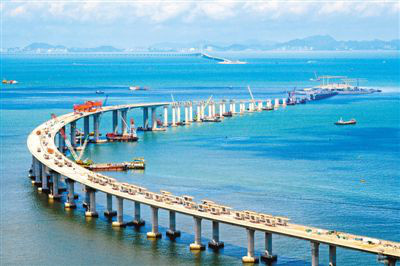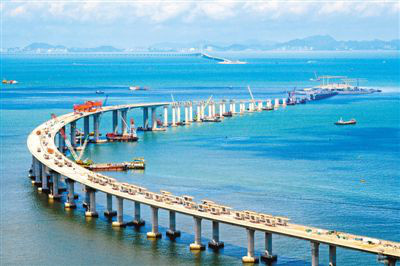By Zhang Qingbo from People’s Daily

The picture shows the Hong Kong-Zhuhai-Macao Bridge under construction. (Photo by Xinhua News Agency)
Hong Kong and Chinese mainland have evolved their relationship into one of comprehensive mutual support and interdependence from merely consanguineous and geographical ties. Their unprecedented intimate ties can be proven by close interaction between governments, communities, and people, as well as synergetic development of the economy, society and people’s livelihood.
The Hong Kong-Zhuhai-Macao Bridge (HZMB) acts as an evidence of such ties. The bridge, which is expected to open to traffic at the end of 2017, will substantially improve the traffic between the Chinese mainland and Hong Kong.
As the first transportation infrastructure project developed by the mainland, Hong Kong and Macao, the HZMB is the world’s longest cross-sea bridge.
It has created a series of miracles and firsts. For instance, the world’s only immersed tunnel was built during the construction. The bridge is the outcome of the close cooperation between Hong Kong and the mainland, and also a miniature of the joint efforts from both parties toward a better future.
Land ports linking Shenzhen and Hong Kong serve as the best proof for the close personnel exchanges over the last two decades. Shenzhen ports saw only 61 million exits in 1997, and the number rose to 239 million in 2016.
In addition, the time spent at the customs has been reduced to five minutes from several hours in the old days, and now it only takes three seconds for cross-border students to go through the customs via self-help procedures.
The severe acute respiratory syndromes (SARS) in 2003 created great fear in Hong Kong, causing 1,755 infections and 296 deaths. The unemployment in the SAR at one point soared to 8.7 percent.
It was the mainland that helped Hong Kong get through the hardship, though the former itself was lacked of enough drugs and medical materials to fight the disease.
Soon after it, the Individual Visitor Scheme for mainland tourists was introduced, followed by the signing of the Closer Economic Partnership Arrangement. These actions have all saved the Hong Kong economy that had been trapped in extreme difficulties.
After the major earthquake hit Wenchuan on May 12, 2008, more than 10 billion Hong Kong dollars was donated by 95% of Hong Kong citizens, and more than 2,000 Hong Kong people went to the stricken area for disaster relief. The prosperity of Wenchuan nowadays is inseparable from Hong Kong’s assistance.
The development of Hong Kong’s financial market in the last 20 years presents an explicit picture of the region’s cooperation with mainland as well.
The value of Hong Kong’s stock market increased nearly 8 times to 28 trillion yuan this year from 3.2 trillion yuan 20 years ago, and the number of listed companies exceeded 2,000, up from 619 in 1997.
Besides, the number of listed China-funded enterprises in Hong Kong has risen from 83 to 1,013, making up 50.4 percent of those listed in the special administrative region and 63.7 percent of its total stock value.
The cross-border investment program of Shanghai-Hong Kong Stock Connect was launched in December 2014, followed by the Mainland-Hong Kong Mutual Recognition of Funds which was introduced eight months later.
Last December, Shenzhen-Hong Kong Stock Connect was approved, while the trading platform Bond Connect officially came into service this May.
“Dramatic changes have happened to the stock market,” said Li Xiaojia, chief executive of HKEX Group.
“We all know that Hong Kong is an international financial center, but it was only a regional one 20 years ago,” Li said, adding that the “one country, two systems” is indeed the foundation for the prosperity of Hong Kong’s financial market both in the past and future.
On January 3, 2017, the then finance chief of Hong Kong Carrie Lam Cheng Yuet-ngor announced that the special administrative region inked a cooperation agreement with the Shenzhen municipal government for common development and the building of a technology park. The largest innovation platform that Hong Kong has ever seen was built after that.
Data showed that 95 percent of the live swine, 100 percent of live cattle, 100 percent of freshwater fish, 90 percent of vegetables, 70 percent of flour, 100 percent of natural gas and 99.9 percent of petroleum in the Hong Kong market are provided by the mainland. It indicated that the cooperation is not only about prosperity, but also about people’s basic needs.
From 1997 to 2016, mainland tourists visiting Hong Kong increased from 2.36 million to 42.778 million, accounting for 76 percent of Hong Kong’s total number of visitors. In the meantime, 81.06 million Hong Kong people traveled to the mainland in 2016, making up 59 percent of the latter’s inbound tourists.
In addition to people-to-people bond, the exchange of needed goods also experienced a boom. The mainland and Hong Kong are both among the largest foreign investors and trade partners for each other. Hong Kong is mainland companies’ most preferred place to go public, and the mainland is Hong Kong’s largest source of material supply and export market.
The Hong Kong-Zhuhai-Macao Bridge (HZMB) acts as an evidence of such ties. The bridge, which is expected to open to traffic at the end of 2017, will substantially improve the traffic between the Chinese mainland and Hong Kong.
As the first transportation infrastructure project developed by the mainland, Hong Kong and Macao, the HZMB is the world’s longest cross-sea bridge.
It has created a series of miracles and firsts. For instance, the world’s only immersed tunnel was built during the construction. The bridge is the outcome of the close cooperation between Hong Kong and the mainland, and also a miniature of the joint efforts from both parties toward a better future.
Land ports linking Shenzhen and Hong Kong serve as the best proof for the close personnel exchanges over the last two decades. Shenzhen ports saw only 61 million exits in 1997, and the number rose to 239 million in 2016.
In addition, the time spent at the customs has been reduced to five minutes from several hours in the old days, and now it only takes three seconds for cross-border students to go through the customs via self-help procedures.
The severe acute respiratory syndromes (SARS) in 2003 created great fear in Hong Kong, causing 1,755 infections and 296 deaths. The unemployment in the SAR at one point soared to 8.7 percent.
It was the mainland that helped Hong Kong get through the hardship, though the former itself was lacked of enough drugs and medical materials to fight the disease.
Soon after it, the Individual Visitor Scheme for mainland tourists was introduced, followed by the signing of the Closer Economic Partnership Arrangement. These actions have all saved the Hong Kong economy that had been trapped in extreme difficulties.
After the major earthquake hit Wenchuan on May 12, 2008, more than 10 billion Hong Kong dollars was donated by 95% of Hong Kong citizens, and more than 2,000 Hong Kong people went to the stricken area for disaster relief. The prosperity of Wenchuan nowadays is inseparable from Hong Kong’s assistance.
The development of Hong Kong’s financial market in the last 20 years presents an explicit picture of the region’s cooperation with mainland as well.
The value of Hong Kong’s stock market increased nearly 8 times to 28 trillion yuan this year from 3.2 trillion yuan 20 years ago, and the number of listed companies exceeded 2,000, up from 619 in 1997.
Besides, the number of listed China-funded enterprises in Hong Kong has risen from 83 to 1,013, making up 50.4 percent of those listed in the special administrative region and 63.7 percent of its total stock value.
The cross-border investment program of Shanghai-Hong Kong Stock Connect was launched in December 2014, followed by the Mainland-Hong Kong Mutual Recognition of Funds which was introduced eight months later.
Last December, Shenzhen-Hong Kong Stock Connect was approved, while the trading platform Bond Connect officially came into service this May.
“Dramatic changes have happened to the stock market,” said Li Xiaojia, chief executive of HKEX Group.
“We all know that Hong Kong is an international financial center, but it was only a regional one 20 years ago,” Li said, adding that the “one country, two systems” is indeed the foundation for the prosperity of Hong Kong’s financial market both in the past and future.
On January 3, 2017, the then finance chief of Hong Kong Carrie Lam Cheng Yuet-ngor announced that the special administrative region inked a cooperation agreement with the Shenzhen municipal government for common development and the building of a technology park. The largest innovation platform that Hong Kong has ever seen was built after that.
Data showed that 95 percent of the live swine, 100 percent of live cattle, 100 percent of freshwater fish, 90 percent of vegetables, 70 percent of flour, 100 percent of natural gas and 99.9 percent of petroleum in the Hong Kong market are provided by the mainland. It indicated that the cooperation is not only about prosperity, but also about people’s basic needs.
From 1997 to 2016, mainland tourists visiting Hong Kong increased from 2.36 million to 42.778 million, accounting for 76 percent of Hong Kong’s total number of visitors. In the meantime, 81.06 million Hong Kong people traveled to the mainland in 2016, making up 59 percent of the latter’s inbound tourists.
In addition to people-to-people bond, the exchange of needed goods also experienced a boom. The mainland and Hong Kong are both among the largest foreign investors and trade partners for each other. Hong Kong is mainland companies’ most preferred place to go public, and the mainland is Hong Kong’s largest source of material supply and export market.
 Menu
Menu
 Caption: The picture shows the Hong Kong-Zhuhai-Macao Bridge under construction
Caption: The picture shows the Hong Kong-Zhuhai-Macao Bridge under construction
















